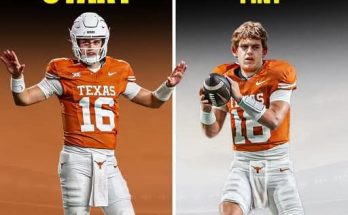Hotel Hallways and Championship Habits: Malaki Starks’ “Last Drive” Mentor Mission Guiding Rookies One Walkthrough at a Time
Malaki Starks laughs when he calls it a “drive,” because there’s no crowd noise, no play clock, no defensive call buzzing through the headsets—just fluorescent hallway light, the low hum of industrial air conditioning, and the echo of cleats (never worn outside, just laced for feel) tapping patterned carpet as a line of wide‑eyed freshmen trails behind him. Yet to the Georgia star safety, those late‑evening rookie hotel walkthroughs are every bit as consequential as a red‑zone stand in the fourth quarter. “Everybody remembers the last drive,” he tells them. “What you do when it’s quiet and nobody’s filming becomes what you do when 90,000 people are losing their minds.” The phrase sticks. So he builds the session around it—“Last Drive”—an informal rite of passage that turns anonymous hotel corridors into a rehearsal stage for poise, alignment, and brotherhood.
It started, he says, because he remembered not sleeping during his own first camp road trip. You think you’ll just crash after meetings. Instead, adrenaline and uncertainty braid together and you stare at the ceiling, rerunning terminology, unsure if you’ll hear the knock in the morning for breakfast check. Starks’ solution for this new crop is empathy disguised as structure. An hour after official lights‑out, when the floor should be settling, he sends a discreet text: “Hall by elevators in five—no notebooks, bring your brain.” They form a crooked semicircle. He points to door numbers like hash marks. “This row is the boundary side. That ice machine alcove is the field side. Sprinkler strobe? That’s the tight end wing. Exit sign far end, treat it like trips into the boundary.” The geography of travel lodging becomes a spatial mnemonic map, a three‑dimensional flash card.
He begins with cadence of communication. One rookie “corners” the first door—imagined receiver splits. Starks crouches, glove-less hands showing the relaxed posture he preaches: not rigid, but coiled. He narrates the pre-snap checklist under his breath the way a piano teacher might press each key, isolating muscle memory for the students around the bench. “Eyes: formation, back depth, quarterback demeanor. Ears: motion call, strength confirmation. Mouth: echo strength if it dies. Feet: be light, don’t marry them to the carpet.” Someone smirks, but he catches it. “Laugh now; when it’s third and three in November you’ll wish you rehearsed how not to freeze your lower half.” He plucks a rookie linebacker forward. “You’re the nickel apex—show me where you live if we spin late.” They rotate like a choreographed shadow cast on beige wallpaper.
Why at night? Because, Starks insists, discomfort is a teacher. “Your brain wants Netflix and sleep. We give it quiet intentional reps instead. Then the game feels familiar, not chaotic.” He walks them through adjustments: imaginary motion; the back shifting from pistol to offset; compressing splits; emergency check to bracket if the “window curtain” (his stand‑in for a slot receiver) cuts its imaginary split tight. He doesn’t drown them in the scheme manual. Instead he threads concepts to anchors: smell of disinfectant equals condensed set alert; ice machine rumble means anticipate sugar huddle disguise; housekeeping cart parked sideways in the morning could represent bunch stack stress. It’s playful coding with a serious subtext—find order in clutter so that on Saturday your eyes aren’t hijacked by pageantry.
After fifteen minutes the initial self-consciousness dissolves. The quiet kid from South Georgia who barely spoke during workouts finds his voice calling out leverage. A former high school two-way star, now relegated to special teams until he learns coverage depths, surprises himself by correctly “rocking and rolling” on a simulated shift. Starks nods without overpraising; credibility as a mentor, he knows, requires both encouragement and standards. “False urgency is noise,” he tells them when they scramble too fast on a phantom tempo cue. “We want decisive calm. Application beats adrenaline.” He resets them, making every rookie breathe in for four counts and out for four, training autonomic composure into the ritual. They re-run the rep cleaner.
He folds in situational football through narrative storytelling. “Alright, it’s the ‘Last Drive.’ Score tie, our offense just punted, two timeouts left for them, ball on their 38. What changes?” A rookie blurts, “Watch seams?” He tilts his head. “Details. Yes, seams, but anchored to clock and field. Use the sideline, know they want chunk plus out-of-bounds. We’re not chasing ghosts—we’re sculpting probability.” He pantomimes a quarterback’s eyes manipulating a deep safety, then shows how to “stay square to both threats until the picture confirms.” A hallway exit sign flickers; he uses it. “See that? Quarterback eyes are like that flicker—don’t lunge at the first flash.” The everyday environment is cannibalized into cognitive drills.
Starks also invests in relational trust. Between scenarios he asks each rookie for one “tell” they rely on—stance tilt, glove flash, back heel weight. Then he gently dismantles overconfidence in those tells. “Cool, but an experienced offensive coordinator will doctor that. So stack cues. Single cue dependency is gambling—stacking cues is investing.” He draws invisible Venn diagrams in the air with his hands, overlapping intangible circles: tendency / formation / down-distance / personnel grouping / field position / game flow. “Where they all overlap? That’s your actionable anticipation. Everything else is highlight-chasing.”
The session evolves to mental recovery. He simulates a blown coverage—points to a random rookie, “You busted. Big gain. Crowd roars, cameras find your face. What now?” Silence. He fills it. “Next snap is either compounding error or resilience rep. Replace the tape in your head with a neutral checklist. Breathe. Reconnect to assignment. You earn veteran status by shrinking the emotional half-life of mistakes.” He grips the hallway railing and uses it as a metaphor: support systems are built before weight hits them. “These walkthroughs are the railing. You don’t notice them until you need stability.”
Halfway through, a housekeeping vacuum hums from another floor. He halts the drill. “Hear that? External noise. We’ll layer it in.” He instructs two rookies to softly hum crowd noise while others communicate, forcing projection and clarity. Words like “Rip,” “Liz,” “Sky,” “Cloud” bounce off framed generic seascape art. He corrects volume modulation—“Don’t scream the whole sentence. Spike the keyword: ‘Rip…Rip…Rip!’ then conversational cadence. Fatigue brain retains spikes.” It becomes vocal choreography.
He ends the technical portion with red-zone geometry using the fire exit map. “Field is compressed. Horizontal stretch becomes vertical stress. Depth is a premium commodity; defend it like it’s oxygen.” He traces imaginary routes with finger laser precision over the laminated evacuation plan: fade, pivot, delay release, leak back line. “Remember: the offense isn’t just calling plays; it’s interrogating your rules. You answer by knowing where rules bend and where they are spine.”
The final minutes belong to ethos. Starks gathers them tight. “Everyone wants the viral play. Few want the invisible preparation that makes the viral play fundamentally sound instead of a lucky guess. These late nights? Invisible capital.” He points to his chest. “Talent got us recruited. Reliability keeps us on the field. Championship DNA is layered micro-habits executed when no scoreboard validates them.” He demands each rookie articulate one habit they’ll upgrade before the next walkthrough—sleep hygiene, post-practice film note structure, hydration timing, pre-snap verbal trigger. They speak—halting, then stronger. He locks eyes with each, sealing micro-contracts.
Curious staffers sometimes wander past, bemused by the silent ballet of gesturing defenders occupying a carpet lane. Position coaches largely approve; they trust his judgment not to devolve into unsanctioned scheme rewrites. To Starks, leadership is action translation: converting abstract standards into embodied practice. The hotel setting amplifies that translation by stripping away the curated aesthetics of practice fields. Here it’s just commitment versus comfort. He intentionally closes with a mundane task: making sure every rookie sets two alarms and identifies breakfast time location. “Operational excellence. Miss the bus, and the pick-six you might have had evaporates. High performance is fragile; protect its scaffolding.”
As they disperse quietly back to their rooms, the hallway returns to anonymity—just patterned carpet, vending hum, and exit placards. But psychological grooves have been carved. Synapses that once fired sporadically around coverage rules now possess an ordered firing sequence. Anxiety displaced by rehearsal frees bandwidth for creativity and reaction come game day. Starks stands momentarily alone, replaying an early rep where a freshman instinctively passed off an inside stem without being prompted. Progress. He knows not every rookie will start, but he wants all of them game-speed literate so that inevitable injuries or rotations do not yank unprepared bodies into high-leverage moments. Depth is not bodies; depth is retained teaching.
The “Last Drive” moniker is intentionally paradoxical. It suggests finality while preparing for beginnings. Starks frames it that way because he wants the rookies to approach every rep—hotel hallway or hostile stadium—as though margin is slim, stakes authentic, and legacy cumulative. He will likely hand this ritual off one day, replaced by another mentor who remembers his own nervous first night. That continuity—an informal, player-led, nocturnal university of details—becomes a competitive edge no analytics dashboard can quite quantify. It’s culture, the most overused and least truly embodied word in sports, made tactile: doorframes as landmarks, exit signs as leverage cues, community built in whispers rather than social blasts.
When dawn filters pale light through generic curtains and rookie alarms chirp, the building occupants stir unaware that twenty yards of hallway carpet doubled overnight as a learning lab. The meeting rooms will fill, film will roll, and coaches will praise or correct. But a quiet secret underpins the rookies’ calmer demeanor: they have already survived a pressure rehearsal that asked them to think, adjust, communicate, and own mishaps in a controlled liminal space. That’s the compounded interest of the “Last Drive.” And for Malaki Starks, who measures influence less in highlight reels and more in the replication of good process across a roster, that is a win recorded nowhere stat services can scrape—yet everywhere that matters once real drives begin.



